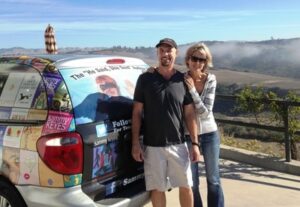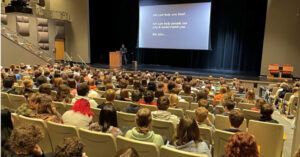 by Mark Parsons
by Mark Parsons
Click here if you missed Part I.
Last time we discussed the overall steps in setting up a book tour. Let’s look at some of the important specifics around booking the events as well as scheduling your travel.
1. The Pitch.
Believe it or not, not every store you contact will immediately say “Oh my God YES OF COURSE!” when you ask about doing an in-store event. It takes time and effort on the store’s part to put on an event, including ordering your books for it, etc., so the store has to do some quick and dirty ROI calculations to determine if they’re going to have a fighting chance of making a few dollars and/or bringing in some new customers in exchange for their time and effort. All of which boils down to your ability to bring people into the store.
Once you let the store know you share the same goals—bringing people into their store—and it sounds like you have a realistic view of how to do that, they’re more likely to want to have you do an event at their store.
2. Setting the Time and Date.
Stores know their local customers and the best times for presentations, and you’ll want to defer to their experience, but much of this is common sense. Weekday visits usually happen in the evenings, after dinner but not too late, like 7:00 p.m. or so. Sometimes I’d try to book a Tuesday in Georgia and the store would say, “We like to do author signings on weekends,” and I have to say, “Well, we’re coming through Atlanta on Tuesday. By Saturday we’ll be in St. Louis.”
Be advised, this is NOT business hardball. They’re a bookstore and you’re an author. You both love books, and you’re on the same team. While you certainly don’t want to cool your heels in a hotel room for three or four days waiting for the perfect presentation slot, we would occasionally defer for a day under special circumstances. Example: NOTHING happens in Nebraska during a Cornhuskers game, so we had a day off in a hotel in Omaha on a Saturday, which is usually a prime day. Overall, the stores were accommodating to our schedule, and we managed to present six-plus days a week for four months during our biggest tour.
3. School Visits.
 As opposed to in-store events which are free, school presentations typically include an honorarium. While we were on book tour, when scheduling allowed, we would occasionally tell the store we’d donate one joint presentation free to a local school of their choosing, during the day of the store event. There were several reasons this made sense:
As opposed to in-store events which are free, school presentations typically include an honorarium. While we were on book tour, when scheduling allowed, we would occasionally tell the store we’d donate one joint presentation free to a local school of their choosing, during the day of the store event. There were several reasons this made sense:
- We were already there with a local event that evening, so we incurred no additional travel costs.
- If it was a significant store and they waffled on having us, this often sealed the deal.
- The store often held a book sale at the school along with the event.
- We always told the students and faculty, “Your local bookstore could have had us go to any school, and they chose you. Remember that when it’s time for you and your school to buy books.”
- We also invited them to their local bookstore that evening if they had more questions, and said for them to bring their families.
- We gave a single 45-minute presentation—long on engagement and entertainment, and short on lecture—and the benefit to the store, the school, and us was well worth the hour out of our day.
4. Booking Lodging.
We booked virtually everything online in advance. At first we booked a few weeks ahead as we traveled, but after a couple of close calls we started booking further in advance, and by the time we did the second leg of the tour we had everything locked down before we even left the house. Logistics matter here, and you can optimize your hotel time with a few little tips regarding how you juggle your presentations and lodging:
We booked in one of three general configurations: the sign-and-sleep, the hit-and-run, and the twofer. The sign-and-sleep is your basic Do the evening event, go to your hotel and sleep, then get up and drive to the next stop routine. It works fine, especially when you have quite a distance between stops. The downside is you don’t get the best bang for the buck, hotel-wise. You’re either arrive in the afternoon, then grab dinner and do the event or depending on how far you drove, arrive in town, then eat, do the event, check in and hit the hay before the next day’s drive.
If we didn’t have a super-long drive to the next stop and/or if the event was reasonably early in the evening, we’d do a hit-and-run, which meant instead of sleeping in the event town we’d do the signing then drive to the next stop and check in, where we’d have a twofer aka two nights in the same place. We’d wake up and have the whole morning or day to hang out at the hotel, go for a run, swim, or sightsee, and get in some serious writing time. After the evening event we could go back to the room and hang out. You get more hotel time for the same monetary outlay, and you only need to unpack and pack up once instead of twice. It always felt like a luxury when we could have a day without having to pack and drive.
Regarding rooms, our basic priority list when booking was:
- National chain. (At least an okay level of quality pretty much guaranteed.)
- Breakfast included. (Saves so much time—and money—in the morning.)
- Indoor rooms. (More comfortable, quiet, and secure than rooms facing the outside.)
- Near the venue and near the main highway.
If there were several that met the above, we’d go with the best price.
In Part III we’ll discuss making sure you have people (and books!) in the store during your presentation.
Mark Parsons is a frequent presenter at conferences, festivals, and schools, speaking on the craft and business of writing. He is a critically acclaimed YA author—his newest novel is The 9:09 Project, out now from Delacorte/Random House. He has written extensively in the nonfiction arena, authoring over two-hundred articles for national publications as well as a pair of nonfiction books.

Pingback: Writers and Publishers Network